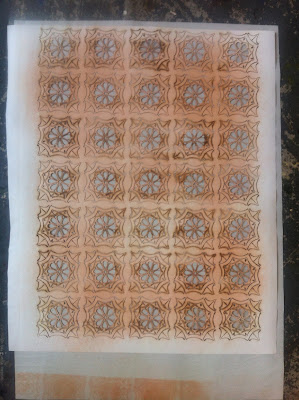Evaluation
Final Major Project – Pattern
Hayley Young
When
I wrote my statement of intent at the beginning of the project, I aimed to
create a garment based on my experience in Marrakech using appropriate colours
and patterns. I wanted to use drapery as
an element as well as laser cutting and etching as an interesting way of using
pattern. As I started my project and tried to realise my ideas I came across a
few problems which made me change my mind and develop my ideas into something I
could work with.
I
was certain I was going to use laser cutting to create my pattern on the final
garment so I developed the design on Illustrator and found a company where I
could laser cut. Once I got there and tried my pattern on the fabrics I had selected,
I realised laser cutting would not work in the way I wanted it to. But I
refused to waste the time and effort I had put into it and made an A2 laser cut
paper stencil of my design which was then used to heat transfer onto my silk
and create my light boxes. I also faced a few
problems with making my patterns and garments. I made my own patterns by
initially making paper toiles and then calico toiles, but I could not figure
out how to make the kind of hood I wanted. I finally managed after about 5
hours of making paper patterns. This was all to be tested again as I tried to
make the garments out of the proper fabric. It was so stringy, that every time
I cut a curve it all came apart. I then had to transfer my sewing machine to
the floor and literally sew centimetre by centimetre and use a scrim fabric as
backing to keep it together. This worked for the dress but the hood would not
be as good or neat I wanted as I could not keep it together.
When
looking back and thinking about what I could have improved on I think I should
have researched my fabric better and found out what would work with laser
cutting. I should have looked further into cutting techniques to try and stop
my fabric from falling apart. I think I did quite well with time management and
roughly stuck to my weekly plan, but I was delayed slightly due to the problems
that came up.
Even
though my detail Ideas changed I feel like I stuck to the basic plan within my
statement of intent and managed to create the look I was trying to get. I stuck
to my colour palette and the natural fabrics I wanted to use. I put a lot of
effort, time and thought into the details and tried my best to do as much as I
could independently. I would have been happier with the result if the stitching
and cutting were a bit neater and the laser cutting had worked, but I am happy
with my finished piece and am proud of what I have learned from the problems
and the experience as a whole.










































